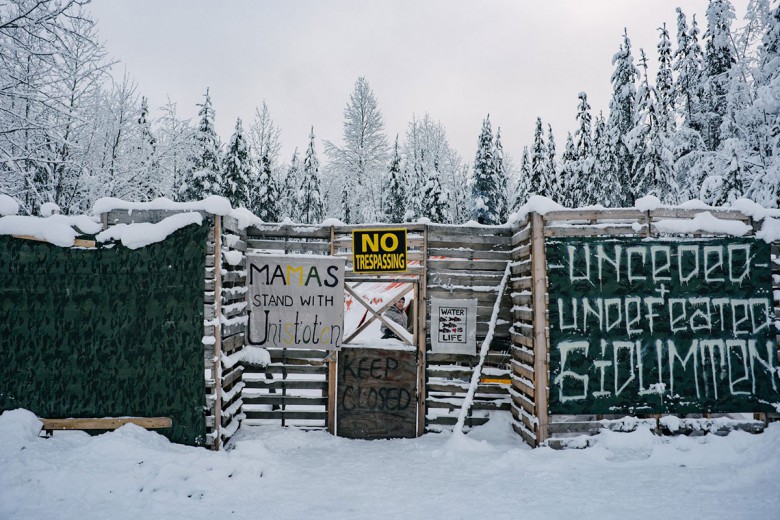On the road leading to a field dotted with tipis at Standing Rock, hundreds of flags from different nations whipped in the wind.
Each flag that flew on “flag road,” including the Treaty 4 flag, has a history of resistance and a modern-day battle with genocide and colonialism behind it. Each flag represented treaties that have been broken over and over again, nations defending their unceded land from settler governments, and Indigenous communities fighting to stop companies from poisoning land and water.
At its peak, Standing Rock had about 20,000 people gathered in the Great Sioux Nation territory, better known as Oceti Sakowin (or the Seven Council Fires). These are homelands that Saskatchewan’s Nakota Assiniboine people shared for thousands of years, before a border split us into Saskatchewan and North Dakota.
Many who gathered in North Dakota returned to their home territories to take a stand against industry in their own backyards. Now, on both sides of that border, Indigenous peoples are fighting again – to stop the expansion of Enbridge’s Line 3 pipeline, which would ship over 700,000 barrels of crude oil each day from Alberta’s tarsands to the Husky oil refinery in Wisconsin.
The pipeline snakes across borders because of the collusion of settler politicians and settler capital.
This article began as an investigation into the Indigenous opposition to Line 3 in Saskatchewan. After all, the pipeline cuts clear across the entire width of this province. But the loudest Indigenous voice in Saskatchewan in opposition to Line 3 has, for a long time, been me, and I already know the landscape. While there is scattered grassroots resistance to the pipeline, there are not many elected Indigenous leaders opposing the project in Saskatchewan.
But thinking about Indigenous pipeline resistance as a set of distinct fights contained within provinces or countries isn’t helpful. The pipeline snakes across borders because of the collusion of settler politicians and settler capital. If we’re going to stop it from expanding, Indigenous resistance must also flow across colonial borders. And despite a lack of visible opposition from Indigenous leaders in Saskatchewan, there are lots of Indigenous people on both sides of that border already fighting to stop Line 3. I hope that this article will provide the strategy, inspiration, and momentum for Indigenous activists in Saskatchewan to escalate their own fight.
Kill the black snake
Line 3 begins in the Canadian tarsands in Alberta, slices a diagonal line across southern Saskatchewan and Manitoba, and extends down through Minnesota into Wisconsin.
Originally built in 1960, it currently carries around 380,000 barrels of crude oil per day from Edmonton, Alberta, to the Husky oil refinery in Superior, Wisconsin. It’s operated by Calgary-based Enbridge, Canada’s largest natural gas distribution company, which also has oil pipelines that criss-cross Canada and the U.S.
Enbridge says the pipeline is corroding – it’s only able to transport half of its original capacity and is at risk of leaking. Line 3 has already ruptured at least seven times – twice in Saskatchewan – spilling over 100,000 barrels of oil.
The existing Line 3 pipeline is being decommissioned, leaving the old pipeline to rot underground. It risks leaching the oil and chemicals it contains into the groundwater and soil. Water can also enter the corroded underground pipeline, leading to the unnatural draining of wetlands. Activists are saying this sets an alarming precedent of pipeline abandonment.
Now, Enbridge is building a new line – the Line 3 replacement – that mostly follows the existing path of the original Line 3 pipeline, except for some route changes in Minnesota. At over $7 billion, the Line 3 replacement would be the most expensive and biggest infrastructure project in Enbridge’s history, and would carry over 700,000 barrels of crude oil per day.
But Indigenous and environmental groups have been appealing the approval, hoping to kill the pipeline altogether by halting construction of the crucial section.
Since the summer of 2017, parts of the pipeline replacement have been built in Alberta, Saskatchewan, and Manitoba, and the section that runs through Wisconsin has been completed. But before the pipeline becomes operational, it needs to be built in Minnesota, and Enbridge is stuck waiting for approval there. Enbridge wanted to begin construction in Minnesota in early 2019, after the Minnesota Public Utilities Commission granted a certificate of need and approved the pipeline’s route in 2018 – but Indigenous and environmental groups have been appealing the approval, hoping to kill the pipeline altogether by halting construction of the crucial section.
“To the depth of a plow”
In Minnesota, the proposed route of the pipeline replacement, and the abandonment of the existing pipeline, crosses land covered by treaties between the U.S. government and the Anishinaabe people (also known as Ojibwe and Chippewa). The 1837 treaty, in which the Anishinaabe ceded land in what is now Minnesota to the U.S. government, promised that “[t]he privilege of hunting, fishing, and gathering the wild rice, upon the lands, the rivers and the lakes included in the territory ceded, is guarantied [sic] to the Indians.” The 1855 treaty between these same two groups, which ceded more land in northern Minnesota to the U.S. government, was signed with the assumption that the 1837 guarantee also applied.
If Line 3 destroys lands and waters, thereby preventing fishing or hunting, or if it destroys the wild rice beds, it’s in violation of these treaties.
In Canada, the pipeline crosses lands governed by Treaties 1, 2, 4, 6, and 7, and the territory of many nations that never signed treaties. When these treaties were signed, Indigenous leaders understood – and told settlers – that they were agreeing to share their land only “to the depth of a plow,” to enable the white settlers to farm. Tarsands extraction and laying pipelines underground unequivocally violate the spirit of these treaties. The Canadian government, however, insists that Indigenous nations “surrendered” our rights to the land and its resources through treaties.
In July 2010, an Enbridge pipeline spilled nearly four million litres of heavy crude oil into the Kalamazoo River in Michigan. It became the largest inland oil spill in American history. In 2017 there was an oil spill on the Ocean Man First Nation in southeast Saskatchewan. That pipeline, operated by Enbridge Income Fund Holdings Inc. until it was sold to Tundra Energy Marketing Inc. in 2016, leaked about 200,000 litres of crude oil.
The oil that spills from Enbridge pipelines also cannot be contained by borders.
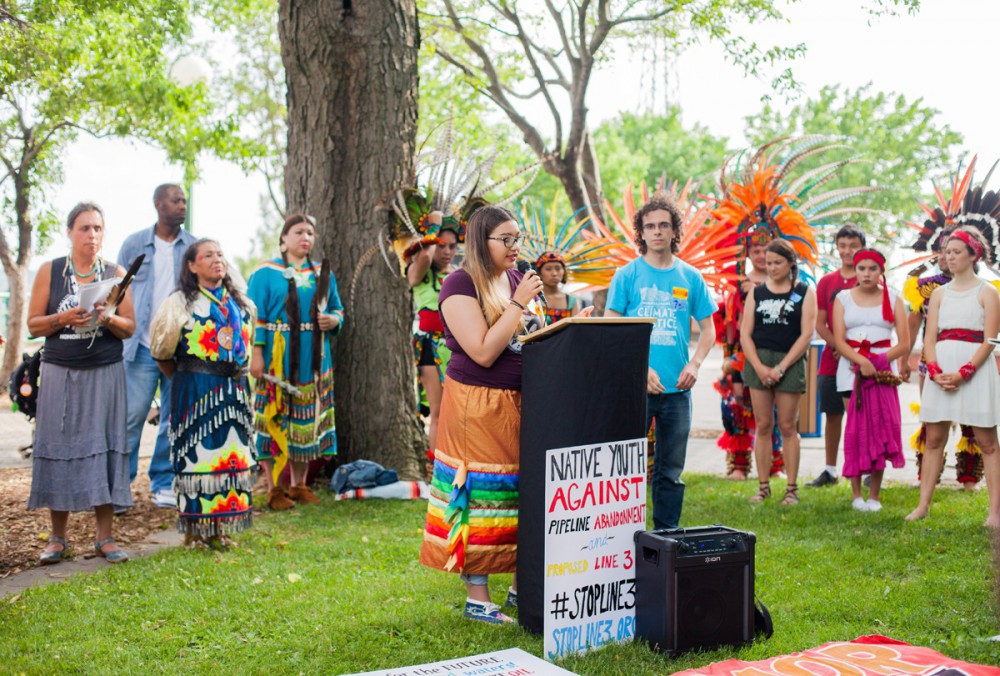
Enbridge currently has 58 agreements regarding Line 3 in place with 95 Indigenous communities and groups, many of whom are along the route of the pipeline. Chief Evan Taypotat of Kahkewistahaw First Nation and Chief Todd Peigan of the Pasqua First Nation, both in Saskatchewan, have professed support for the pipeline, citing the employment opportunities that the pipeline would provide.
The pipeline runs under the Qu’Appelle River in Saskatchewan, but Peigan says that Enbridge’s activity near the river will be monitored by the First Nation. Enbridge estimates the pipeline will create about 9,175 direct, indirect, and induced jobs in Saskatchewan. But oil companies are notorious for exaggerating the number of jobs they predict their projects will create, and it’s likely that the vast majority of jobs will be temporary. For example, in 2013 Kinder Morgan told the National Energy Board that constructing their Trans Mountain Expansion pipeline would require an average of 2,500 workers per year for two years, with 90 permanent jobs – but Kinder Morgan’s website now pegs the number at 800,000 “direct, indirect and induced person-years of employment.”
But for some Indigenous communities, which have been systematically impoverished by settler governments for years, the prospect of new employment and skills training – however temporary – is seductive enough to ally with an oil company.
Paddle to Protect
In August 2017, I was arrested during a protest on the Minnesota and Wisconsin border. Our protest halted work on the construction of Line 3 – I stood at the side of the road, holding a sign that read “LOVE WATER NOT OIL.” To date, I am still the only “Canadian” who has been charged with “disorderly conduct and resisting arrest” in the Line 3 protests. Being torn away from my daughter and thrown into a jail cell was a traumatic moment for both of us. I had flashbacks to the clouds of tear gas and rubber bullets at Standing Rock. It was my first arrest and my first set of charges, and I was reminded that settler states will wield the law to shut down any threats to big oil companies.
Between August 12 and September 2, 2017, youth from Saskatchewan and Minnesota joined the Paddle to Protect journey, a 400-kilometre canoe trip down the Mississippi river in northern Minnesota that kicked off the protests against Line 3. A group of young warriors came together from the Lakota, Nakota, Anishinaabeg, Aztec, and Cherokee nations, among others, to protect the water, the wild rice beds, the medicines, and their futures. They lived along the river for weeks, setting up camp every night and dining on wild rice and fish harvested from that same river.
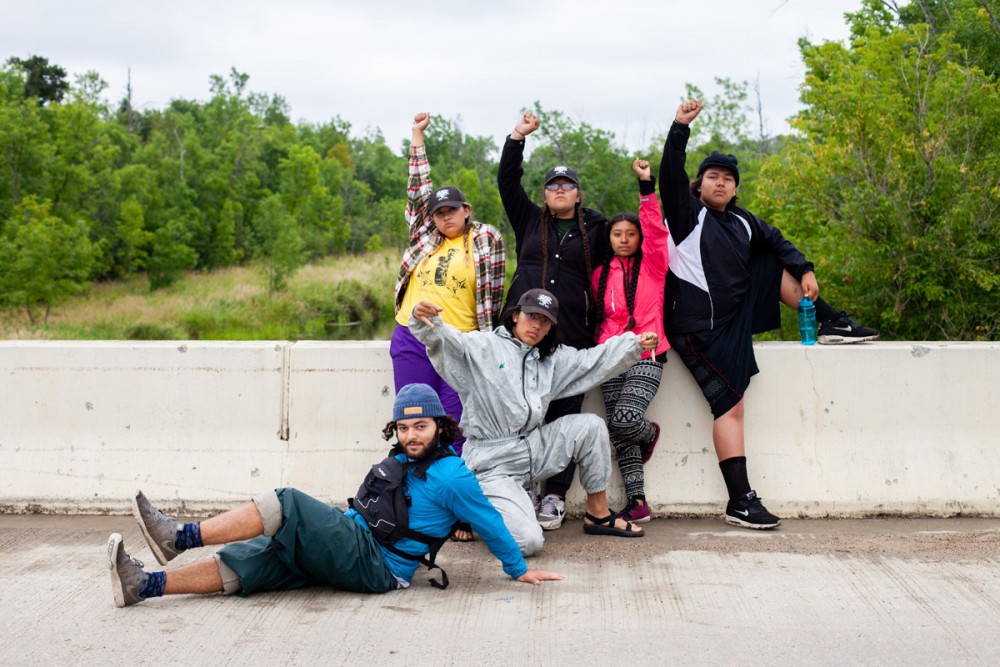
Shanaya Buffalo, a 15-year-old Anishinaabekwe from Regina, reminisced about her summer in Minnesota. “Protecting something so sacred and pure is the greatest thing you can do,” she tells me. “Fighting for something so dear in everyone’s heart is beautiful yet sad, because there is only so much we can do.”
My daughter, Valyncia Sparvier, is a 15-year-old Nakota/Anishinaabekwe from White Bear First Nation in Saskatchewan. She was raised fishing, swimming, and living on a lake near Sakimay First Nation. Sparvier also visited Standing Rock on the weekends during the Dakota Access Pipeline fight, but she’s been a water protector her whole life.
“Being able to drink clean water is a necessity that everyone needs, but most Indigenous communities struggle to have a drop of clean water,” she says with a trace of heartbreak. “I strongly believe that you should fight for what you love, and without water we won’t be alive. So when I found out about the Paddle to Protect, I just loved the idea of being near water, while raising awareness [about the Line 3 fight].”

“A spiritual war”
As Line 3 construction began, it was met with Indigenous resistance camps along its route, determined to protect the wild rice beds, the great lakes, and traditional lifeways. In Minnesota there’s Camp Makwa, Camp Turtle Island, and Ma’iingan Prayer and Cultural Camp – plus other camps that I won’t name or share the location of. Because of the history and ongoing threat of infiltration/surveillance, some camps are open only to trusted warriors.
In Minnesota, this is not their first Enbridge pipeline fight. From 2013 to 2016, Winona LaDuke, along with many other Minnesotans, opposed Enbridge’s Sandpiper pipeline. They successfully saw Enbridge cancel their proposal before a pipe could be laid. However, the Line 3 replacement project is hot on its heels. LaDuke is the executive director of Honor the Earth, an organization that does education, coordinates actions, and fundraises for grassroots Indigenous environmental groups.
On July 11, 2018, the Spirit of the Buffalo Camp was erected on traditional Dakota land in Treaty 1 territory. The camp is right on the U.S.–Canada divide near Gretna, Manitoba, where Line 3 crosses the border more easily than many Dakota people can. A sacred fire has burned there ever since.
“This is a spiritual war, and I’m in prayer here a lot. I can’t even begin to explain what I’m doing when people say I’m not doing anything.”
The Spirit of the Buffalo Camp, with the support of the Manitoba Energy Justice Coalition (MEJC), works to educate the surrounding settler communities on issues that exist with pipelines and their construction, like the climate impact of burning fossil fuels, and missing, murdered, and exploited Indigenous women and girls.
This camp became home to Geraldine McManus, a Dakota mother who is no stranger to pipeline fights. She also stood with Standing Rock two years ago. Despite the racism and intimidation she’s faced over the months, McManus has no plans to retreat any time soon. She tells me about a visit from an armed man in a truck with Alberta plates who yelled threats at campers. These incidents further confirm the dangers that Indigenous women face for simply existing and peacefully protesting on their traditional homelands.
“It hurt my spirit to be subjected to so much hate,” McManus tells me. “This is a spiritual war, and I’m in prayer here a lot. I can’t even begin to explain what I’m doing when people say I’m not doing anything.”
Most days McManus sits not far from the new Enbridge pumping station. She’s able to watch the pipeline activity on the American side of the border. At one point she was questioned by border security from Canada and the U.S. But mostly she ventures into local towns such as Gretna to engage with the community, so they are aware of why she is out there, hunkered down for the winter, living in a waganagon (a traditional Indigenous home that predates Canada).
This education means making clear the relationship between pipelines, environmental destruction, and the negative impacts to communities. Pipeline construction projects are often accompanied by higher rates of human trafficking, drug trafficking, violent assault, and sexual assault, and especially impact people in nearby First Nations. Areas that host the “man camps” of transient, mostly male pipeline workers have seen numbers of reported domestic violence incidents and sexual assaults double or triple.
The art of activism
In December I attended a fundraiser in Minneapolis called WATER, a collaboration of art and music to support the movement against Line 3. The night saw performances by New York underground hip-hop legend Immortal Technique, and Indigenous hip-hop artists like Nataanii Means and Tufawon (Rafael Gonzalez).
Both Means and Gonzalez have been actively opposing Line 3 in Minnesota. They are a part of a group called the Ginew Collective, which has been camped for many months through the permit process in Minnesota, where Enbridge was granted a certificate of need to run through the state last summer.
On December 21 – the same day as WATER – it was announced that the state of Minnesota is suing itself over its decision to grant a certificate of need for Line 3.
The Minnesota Department of Commerce appealed the Minnesota Public Utilities Commission’s decision, with outgoing governor Mark Dayton explaining that Enbridge “failed to demonstrate that Minnesota needs this pipeline to meet our future oil demand.” It’s the seventh active Line 3 lawsuit against the state of Minnesota – most of the suits have been filed by Indigenous tribal governments and organizations like Honor the Earth, Youth Climate Intervenors, and Friends of the Headwaters.
“Every day we have to pass something that reminds us that we were imprisoned in our own lands.”
Means began his set by acknowledging the traditional Dakota territories we were on. He was also in Standing Rock for many months, enduring the violent military siege and bitter cold of the Prairie winter.
“We live with our trauma,” he emphasized. “Every day we have to pass something that reminds us that we were imprisoned in our own lands.” He spoke of the status cards we carry that determine how Indigenous we are, attaching our names to numbers.
Nataanii Means is the son of American Indian Movement (AIM) leader Russell Means, who was seminal in the occupation of sites such as Wounded Knee, the Black Hills, and Alcatraz. “I came from a family of resistance, from warriors,” he continued. “People that fought against the government.”
WATER reminded me that art has always connected Indigenous activists on a global level – from prophecies and protest banners to resistance music and spoken word poetry. So while there isn’t anyone locking down to pipelines in Saskatchewan, there is definitely someone locking down somewhere for Saskatchewan.
Indigenous peoples of Turtle Island didn’t see borders when they coexisted in harmony with the ecosystem for thousands of years. When we limit our thinking to the confines of colonial borders, we fail to be good neighbours. When we prioritize economic prosperity without thinking of ecological impacts, we fail to be good ancestors.
“The Dakota, the Anishinaabe brothers and sisters, they came to Puerto Rico with me and made sure the water we were drinking down there was clean.”
Maria Isa, a Puerto Rican singer who performed at WATER, explained how she came to stand in solidarity with the Line 3 resistance. “My tribe in Boricua, it didn’t have water for a long time and it still doesn’t have a lot of clean water right now,” she explained. “The Dakota, the Anishinaabe brothers and sisters, they came to Puerto Rico with me and made sure the water we were drinking down there was clean.”
“I may be Boricua and he may be Mexican, but we don’t have borders. And when we come here, in the land of the Indigenous people here, we fight for all of our movements. Because the water is what puts us together.”
The print version of this article stated that “Line 3 has already ruptured three times – east of Regina, Saskatchewan, in 1999; near Hardisty, Alberta, in 2001; and downstream of Glenavon, Saskatchewan, in 2007 – spilling a total of nearly 50,000 barrels of oil onto farmland and wetland.” In actuality, Line 3 has ruptured at least four more times in addition to the above incidents, spilling over 100,000 barrels of oil.


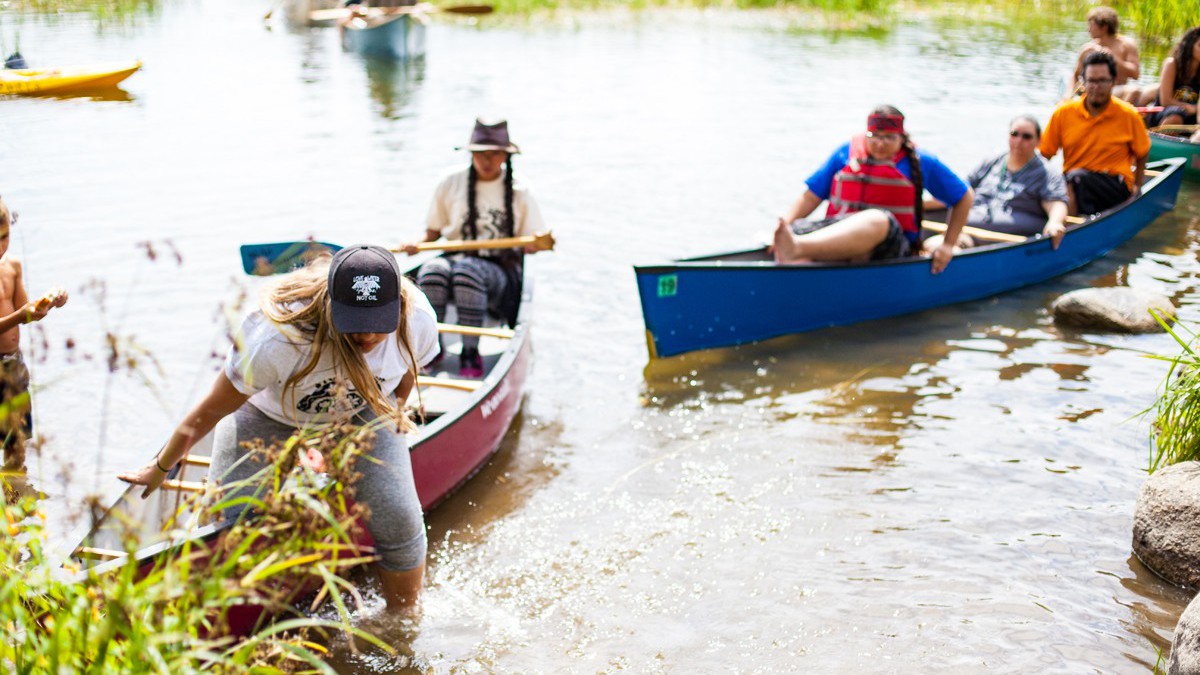
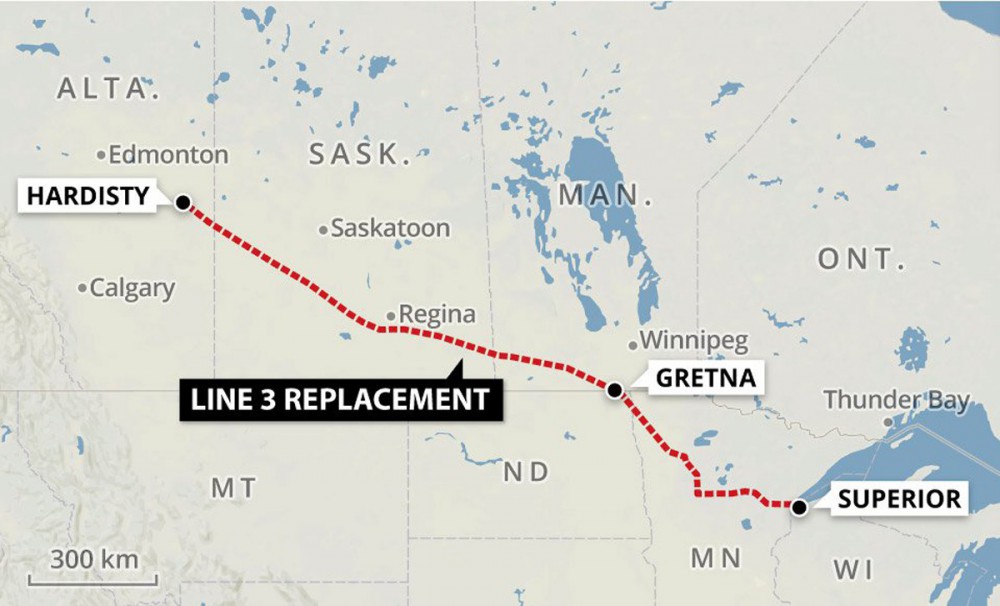
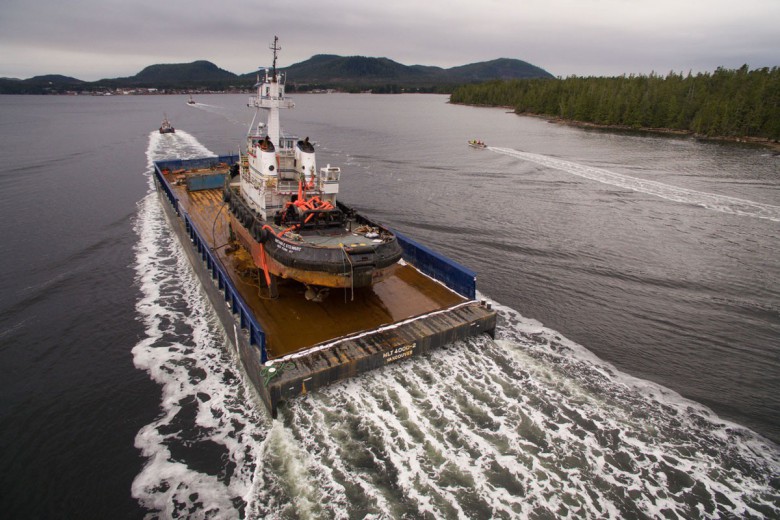
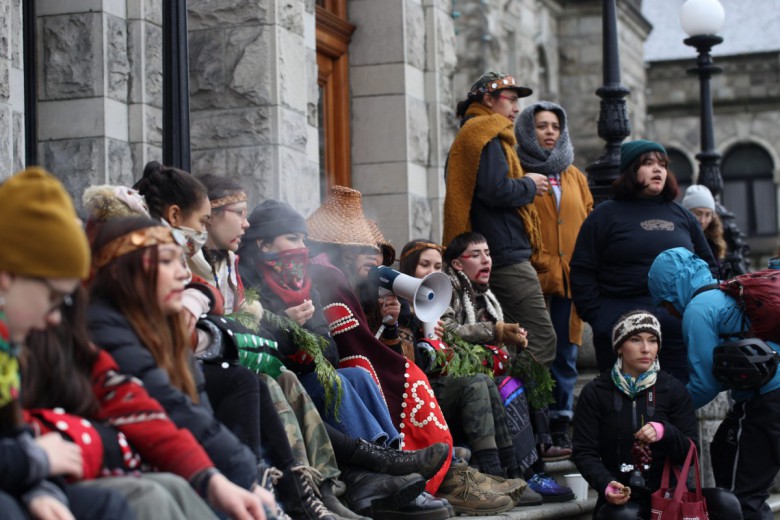
_780_520_90_s_c1_c_b.jpg)
